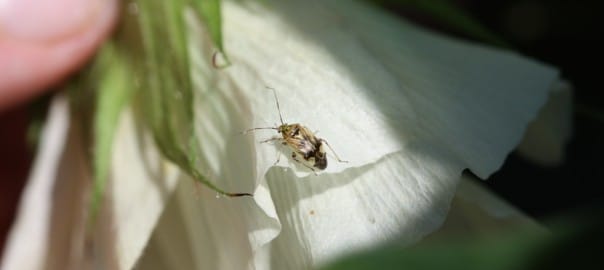Hemp is an agricultural crop grown worldwide and prized for its ability to be used for paper production, building components, products for human and even animal consumption through the seed, and health and beauty products based on hemp oil. (Hemp oil is a major by-product from crushing hemp seed.) Continue reading
Recent Updates

Sugarcane aphids, whorl-feeding caterpillars, and bees in sorghum
Sugarcane aphids have now been confirmed in Shelby County. The good news is that populations are very low at this time, and it seems to me that we are on a similar schedule as last year. Thus, I’m hoping that much of the early grain sorghum will be at low risk to serious infestations. The bad news is we seem to be on a similar schedule to last year, and we should anticipate that Continue reading
Corn Borers in Corn
This is mostly a repeat of an article from last year and is intended as a reminder not to overlook corn borers, especially southwestern corn borer, in non-Bt corn. The second generation moth flight is starting. Overall moth catches have been low (click here for moth trapping data), but corn borer infestations can be Continue reading
Crop Progress
As reported by NASS on July 6, 2015
DELTA FARMERS EXPERIENCE FLOODING
Some farmers along the Mississippi River dealt with flooding issues as the river rose. Widespread rains brought much needed moisture to the rest of the state. The heaviest of these rains have diluted applied herbicides, forcing many soybean producers to concentrate on weed control. Continue reading at Crop Progress 7 5 15.
Soybean Acreage Up, Corn Unchanged (June 30 NASS report)
Soybeans planted in Tennessee were estimated at 1.85 million acres, up 210,000 acres from 2014. Acres harvested for grain, at 1.82 million acres, was 210,000 acres above a year ago. U.S. soybean planted area for 2015 was estimated at 85.1 million acres, up 2 percent from last year. Area for harvest, at 84.4 million acres, is up 2 percent from 2014. Continue reading at June Acreage Press Release_TN.
Tennessee Market Highlights
Corn, soybeans, and wheat were up; cotton was mixed for the week. In the past three weeks, December corn futures have rallied nearly 70 cents and are currently higher than last year at $4.37. During the same time, November soybean futures are up $1.30 closing on Thursday at $10.30. Continue reading at Tennessee Market Highlights.
USDA Acreage and Quarterly Grain Stocks Reports, June 30, 2015
On Tuesday June 30th the USDA surprised the market releasing decidedly bullish estimates for corn, soybeans, cotton, and wheat. The Acreage report provided the primary catalyst for corn and cotton price increases. The Quarterly Stocks report keyed the increase in soybean futures. Weather remains on everyone’s mind as excessive rain in many areas has: delayed wheat harvest; prevented corn, soybean, and cotton plantings; and adversely affected crop conditions. As we move forward, weather will be the primary market driver. The question to be determined is which direction will the market (and weather) go from here? Continue reading at USDA Acreage & Quarterly Grain Stocks Report. This includes an Profitability Outlook update.

Dealing with plant bugs during early bloom
Tarnished plant bug infestations in pre-flowering cotton have been pretty typical thus far … sporadic infestations with many but not all fields requiring at least one treatment. Realistically, I expect more consistent problems as we move through July. Below are a few thoughts about the best management practices for plant bugs over the next two weeks.
- Consider using a sweep net and a drop cloth in tandem during early bloom. As we progress further into bloom, I prefer the drop cloth because the population often shifts primarily to immatures. However, the 14 days just before and after bloom is a time where we might see mixed populations of nymphs and adults knock off squares and feeding on small bolls.
- Continue monitoring square retention in the top five nodes for 10-14 days after first bloom. Monitoring square retention after this point is generally not suggested for a couple of reasons. Later squares will not contribute much to yield. You can also get a ‘bad read’ as squares will naturally shed as the plant develops a fruit load.
- Treat for plant bugs when infestation levels average 15 or more plant bugs per 100 sweeps or when 3 or more plant bugs per drop cloth. It is very likley a second spray will be needed at a 4-5 day interval if infestations are several times threshold, particularly when the population is composed mostly of immatures.
- Use the right insecticide! We have several excellent treatment choices for cotton just prior to flowering and during the first two weeks of bloom. This is an good window for the use of 1.5 oz of Transform (1.5 oz/a) or Diamond (4-6 oz/a and usually tank mixed with Orthene/Acephate or Bidrin). Transform and Diamond provide unique modes of action. This is also a time where Acephate (0.67 – 0.75 lb/a) or Bidrin (5-8 oz/a) work well by themselves, although many will reserve the use of these products as tank mix partners with pyrethroids until later in the season when stink bugs and bollworms are a bigger part of the equation.
- Don’t use the wrong insecticides. Pyrethroid insecticides applied alone will provide little or no control of tarnished plant bug. Also, I suggest laying off neonicotinoid insecticides such as Centric or the imidacloprid products once past first bloom, in part for resistance management but also because they just don’t work as well in this window as immature plant bugs are a growing part of the population.
Note – Bidrin is not labeled for use during the interval of first square to first bloom. Please follow the label restrictions for this and other insecticides.

